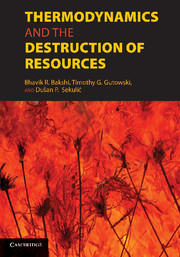Book contents
- Frontmatter
- Contents
- Contributor List
- Foreword by Herman E. Daly
- Foreword by Jan Szargut
- Preface
- Introduction
- PART I FOUNDATIONS
- 1 Thermodynamics: Generalized Available Energy and Availability or Exergy
- 2 Energy and Exergy: Does One Need Both Concepts for a Study of Resources Use?
- 3 Accounting for Resource Use by Thermodynamics
- PART II PRODUCTS AND PROCESSES
- PART III LIFE-CYCLE ASSESSMENTS AND METRICS
- PART IV ECONOMIC SYSTEMS, SOCIAL SYSTEMS, INDUSTRIAL SYSTEMS, AND ECOSYSTEMS
- Appendix: Standard Chemical Exergy
- Index
- References
2 - Energy and Exergy: Does One Need Both Concepts for a Study of Resources Use?
Published online by Cambridge University Press: 01 June 2011
- Frontmatter
- Contents
- Contributor List
- Foreword by Herman E. Daly
- Foreword by Jan Szargut
- Preface
- Introduction
- PART I FOUNDATIONS
- 1 Thermodynamics: Generalized Available Energy and Availability or Exergy
- 2 Energy and Exergy: Does One Need Both Concepts for a Study of Resources Use?
- 3 Accounting for Resource Use by Thermodynamics
- PART II PRODUCTS AND PROCESSES
- PART III LIFE-CYCLE ASSESSMENTS AND METRICS
- PART IV ECONOMIC SYSTEMS, SOCIAL SYSTEMS, INDUSTRIAL SYSTEMS, AND ECOSYSTEMS
- Appendix: Standard Chemical Exergy
- Index
- References
Summary
Introduction
In Chapter 1, the concepts of thermodynamics were introduced, and a consistent exposition of thermodynamics' basic laws and associated system properties was offered. Out of an infinite set of properties and a limited number of defined interactions, only a few are relevant in any given study, and these include a limited number of independent system properties. This chapter is devoted to a further elaboration of two such fundamental concepts that belong to a class of system properties: (1) energy and (2) exergy. The main purpose of this exposition is threefold: (1) to offer a discussion of physical meanings of these concepts; (2) to present their analytical structure within the traditional thermodynamics framework; which is useful for applications; and (3) to emphasize the importance of balancing them. These topics are relevant for a variety of situations in diverse fields of interest, all identifiable in complex systems involving destruction of resources.
The notion of a concept is used to describe abstract theoretical constructs of classical thermodynamics theory. The concept of energy [1] is reintroduced in this chapter by means of a notion of a change of a system property; the concept of exergy [2] is reintroduced by means of the magnitude of an energy interaction. This magnitude would be expressed in energy units, but would be measured as an interaction extracted from the system changing the state between the given state and the state of thermodynamic equilibrium with the referent surroundings.
- Type
- Chapter
- Information
- Thermodynamics and the Destruction of Resources , pp. 45 - 86Publisher: Cambridge University PressPrint publication year: 2011



